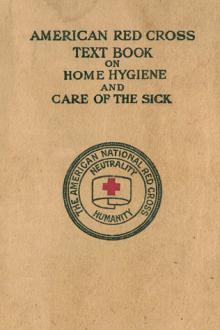American Red Cross Text-Book on Home Hygiene and Care of the Sick by Isabel McIsaac (best affordable ebook reader txt) 📕

- Author: Isabel McIsaac
- Performer: -
Book online «American Red Cross Text-Book on Home Hygiene and Care of the Sick by Isabel McIsaac (best affordable ebook reader txt) 📕». Author Isabel McIsaac
When a patient asks for the bedpan it should be brought if possible without a moment's delay, not only because no other form of neglect makes a patient realize her helplessness more acutely, but also because the desire to use it often passes quickly and delay may encourage the habit of constipation. If the patient does not ask for the bedpan, the attendant should offer it at suitable times. Bedpans should be warmed before use. An easy way to warm one is to let hot water run over it; the outside should afterward be dried.
To place the bedpan, first flex the patient's knees and push the night gown up; place one hand under the patient's hips, raise them slightly, and with the other hand slip the pan into place. If the patient is entirely helpless two persons are needed to lift her. Place a pad or folded cloth between the patient's back and the pan; then lower the patient gently. Before removing the pan, bring toilet paper, water and two pieces of soft old muslin or gauze. A patient, if able, prefers to use the toilet paper without assistance; her hands should afterward be thoroughly washed. If she is unable, the attendant must do everything needed. After the patient has been cleaned as thoroughly as possible with paper raise her hips with one hand and then remove the pan; it is important to raise her first because the skin often adheres and may be injured if the pan is suddenly pulled away; carelessness in managing the bedpan has caused more than one bed sore. Then remove the pan with one hand and cover at once. Turn the patient, if helpless, on her side, wash the parts with one piece of old muslin, thoroughly dry them with the other, and either burn or thoroughly wash both pieces afterward.
Empty the bedpan and clean it at once; ordinarily one can clean it without wetting or soiling the hands. Use cold water first, removing all adhering solid particles with a tightly rolled piece of toilet paper. Do not use a brush for this purpose. After using cold water, rinse the pan thoroughly in hot water, and at least once a day wash it well in hot soapsuds. Directions for disinfecting the pan will be given later, but remember that a properly kept pan needs no deodorant solution. Glass urinals should be provided for men, and kept clean in the same way. Contents of both bedpan and urinal should always be carefully inspected; neither should be emptied in the dark.
DAILY ROUTINE IN THE SICK-ROOMObviously the routine of a patient's day must vary according to her condition, her preferences, and the amount of time the attendant has to give her. The temperature, pulse, and respiration must be taken and all medicine, nourishment, and treatment given at the exact times ordered, but the attendant should learn whether or not the doctor wishes her to wake the patient for food or treatment. Good management in the sick-room depends upon foresight and planning, and therefore it is well to keep in mind the following suggestions:
Vitality is lowest in the early morning, hence baths and treatments, especially if they are fatiguing or painful, should if possible be left until after breakfast. Patients often wake early and wait, weak and miserable, for the day to begin. A hot drink at this time may give relief and enable the patient to sleep again. Even though breakfast time is near, nourishment should be given as soon as the patient wakes. She may not admit that she is hungry, but her nourishment should not be delayed until the family breakfast is ready, or still worse, finished.
Before breakfast the bedpan should be offered, the patient's face and hands should be washed, her teeth brushed, her hair tidied, the bed straightened, and the room put in order. These services should require a few minutes only. The room if properly arranged at bed time needs only a little attention now unless untidy work has gone on during the night; disorder in a sick-room is as unnecessary in the early morning as at any other time.
After the patient has finished her breakfast she may rest, or if allowed, read her mail or the newspaper while the attendant prepares for her day's work; about an hour after breakfast the patient should be bathed, unless she prefers her bath in the evening. After the bath some form of light nourishment should be given, even to a patient who has regular meals. If a patient is able to sit up in a chair, the best time for her to do so is generally just after the bath and toilet have been completed; but if she feels tired she had better wait until afternoon. The bed room can be better aired and cleaned if it is possible to take her into another room; and she herself generally profits by a change of scene.
The doctor should definitely state when and for how long a patient may sit up for the first time after an illness, and an amateur who may be ignorant of the dangers involved should not assume the responsibility of deciding. When a patient is to sit up for the first time, put on her stockings, slippers, and wrapper before she leaves the bed. Arrange an arm chair with pillows in the seat and at the back, bring it close to the bedside and cover it with a large blanket unfolded. The chair may face either the head or the foot of the bed. Help the patient to a sitting position on the extreme edge of the bed, with her feet hanging down. Next, standing in front of her and supporting her well, let her slip down until she stands upon her feet, then let her turn, and gently lower her into the chair. See that the patient while sitting up is warmly covered, and that her foot-stool, pillows, etc., are adjusted comfortably. Move her chair so that the outlook may be as interesting as possible, and at least a little different from the view from the bed. Most patients like to look out of the window; children and old people enjoy it particularly.
If the patient shows signs of fatigue, she should go back to bed even before the appointed time. To help her back to bed, reverse the process of helping her out. A footstool may be needed if the bed is high, or two people to lift her if she is weak or heavy. When a patient is in bed no one should ever sit on the bed, lean against it, use it as a table for folding linen, making pads, etc., take hold of the bed posts in passing, or touch the bed unnecessarily in any way.
The best time for visitors is the last of the morning or the early afternoon. A judicious visitor may do an immense amount of good, especially to a chronic patient; indeed, she may be the only ray of light in a dark day. Subjects of conversation should be pleasant, but not too stimulating or exciting. The visitor should be prepared to carry the burden of the conversation, to drop topics skillfully that seem to involve fatigue or excitement, and either to go or to stop talking if the patient seems tired. Visitors should remember to talk naturally and cheerfully on ordinary topics, and to avoid excessive sympathy and labored attempts to cheer the patient. They should also remember that few patients bear well even the mildest forms of teasing. The patient's room is not the place to discuss personal or family troubles; yet it is only too often chosen for such purposes, probably because the complainer knows that in it an audience is always to be found.
Visitors not belonging to the family should not be present in the sick-room during treatment of any kind, unless their help is required; neither, as a rule, should they stay during the patient's meals. A member of the family may stay with advantage if the patient tires of eating alone, but casual visitors almost invariably offend by undue urging if the patient's appetite is poor, or by facetious remarks if it is good.
Ordinarily only one visitor should be admitted at a time, since a weak patient may be tired merely by looking from one to another. If it is desirable to limit the call, the attendant should tell the visitor beforehand how long to stay, or arrange a signal for the visit to end. To announce baldly in the sick-room that the patient is tired and the visitor must go, will only elicit aggrieved protests from both. In illness lasting only a day or two all visitors should be discouraged; during colds, because they are communicable; during general fatigue, headaches, digestive upsets, and painful menstruation, because rest and quiet are highly desirable. Visitors at such times too frequently give injudicious sympathy, and may actually delay the recovery of patients who enjoy playing the rôle of interesting invalid.
The time when a trustworthy visitor is present may be the best time for the attendant to rest. The patient should be told when the attendant is going, and approximately when she will return. It is a mistake to slip away while the patient sleeps; she seldom fails to wake before the time scheduled and to resent the desertion. Surprises of any kind, pleasant or unpleasant, are seldom good for patients.
Toward the end of the afternoon the patient is probably tired, especially if she has not slept during the day. When fever is present her headache and restlessness increase as the day goes on, but it should be remembered that uncomfortable beds and too heavy covers cause much of the restlessness attributed to fever. Rubbing the back and legs with alcohol, giving a tepid sponge bath, remaking the bed or changing her position may help to soothe her.
The evening should be kept free from excitement, and every possible effort should be made to encourage sleep. It is a mistake to think that a better night results from keeping a sleepy patient awake all the evening; sick people should sleep when they can. Just before bedtime the attendant should prepare her own cot, and then make the following preparations for the patient to sleep: wash the patient's face and hands or give a sponge bath if it is desired, brush the hair, change the night gown, brush crumbs from the bed, tighten the sheets or remake the bed if necessary, rub the back and other pressure points with alcohol, shake the pillows, give liquid nourishment, preferably hot, cleanse the mouth, and give the bedpan. See that the patient's feet are warm, the bed covers right, the room ventilated properly and in good order, and the light extinguished or arranged for the night. If the patient is inclined to be wakeful a hot foot bath may help her, or sponging the entire length of the spine for fifteen minutes, using very hot water and long downward quiet strokes. No conversation should be encouraged during preparations for the night. Patients in bed all day often lose the habit of sleeping at the regular time, and lie awake far into the night from a vague feeling that someone else is coming or something further is to be done for them. Consequently last of all ask the





Comments (0)